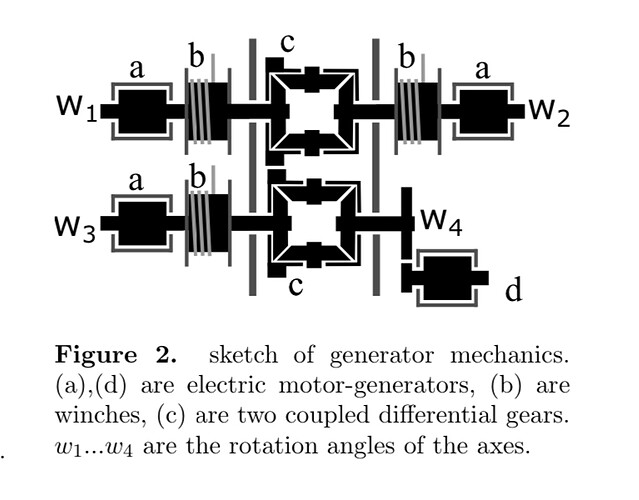My starting point with the three tether version of Payne #5 would be to look at the speed of the tether in the generator. If it is not very high, I would immediately suspect issues with tether mass/weight when scaling. Any sag developing at the slack tether will have to be taken up by the kite. This will reduce the effective stroke.
I seem to remember though, that we discussed Payne #5 earlier.
Lets assume that the tether forms an equilateral triangle where the distance between the legs is a ratio 1:n relative to the length of the legs. Then assume the kite is moving at a speed 2.5 * 2/3 ~ 1.7 times the wind speed (flying at glide ratio times a third slowdown due to harvesting power). In that case the speed of the tether at the power takeoff is 1.7 / (2n) times the wind speed. For n = 4 this makes sense, giving a tether speed of 0.2x windspeed [compared to 0.33x for yoyo].
This would mean though that is the front leg was totally slack and the rear leg was totally taught, that rig would produce less power than a yoyo based rig, with the only benefit being not flying downwind.
What I make of this is that the 1:n would only make sense for small values of n, maybe 1 < n < 3, maybe even smaller. This means again that the AWE rig would have to be large and flat and not really going to huge altitudes.
It also means that if you could make a kite more efficient, say a glide ratio of 10, you could go much higher and still use the Payne #5 concept.
Anyways - if you go low n, the tension in the tether will increase a lot. If you go high n, you will lose the ability to transfer power. You can’t add more tension with large n because the kite only provides so much lift.
For low n, you will get a high tension on the tether as the kite is pulling upwards while the legs will be stretched out. If it is high enough, tether mass will become an issue, in particular at scale due to square-cube scaling (square for kite area, cube for tether mass).
Anyways, I must conclude that Payne #5 could make sense, in particular with the right value of n and preferably more efficient kites.
If you extend from two to three legs, the winch speed will vary more depending on the wind direction, and the power takeoff must be in more than one place I presume. This will add a lot to the cost both because of more equipment, but also because the reeling speed will not be ideal much of the time. I will not analyze this further though.
For the AKN though the problem is maybe much worse as you can’t use the tether in a loop (connecting the two legs). So you maybe must use the motor to hold a force without producing power. Take for instance the legs facing 90 degrees to the network; they must have a huge tension but do not reel at all. As there is no practical way to make those legs “round trip” the tension must be maintained by either a brake or a motor. A motor will have large losses in such operation, and a brake is only feasible if there is absolutely no movement on the tether [which will only be true for legs accurately aligned to 90 degree to the wind].
That being said, I still don’t think the AKN is practically viable. I don’t see the point in debunking this based on pure speculation, when the authors have done such a poor job at actually describing what they would like to do.
Sorry for meandring in my reply here.

